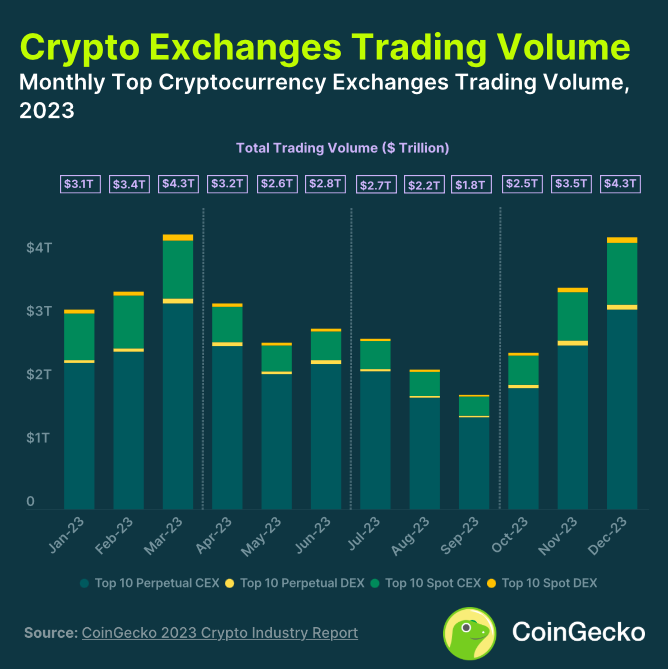The so-called Coinbase premium has evaporated, indicating a weaker stateside buying pressure.
4 Surprising Insights From Coinbase’s Earnings, COIN Sees Bullish Surge
The foremost crypto exchange in the United States, Coinbase, released its earnings report on February 15th. As expected, there were major takeaways from the financial report, highlighting the crypto company’s performance in the fourth quarter of last year.
Coinbase’s Trading Volume Exceeds Expectations
Coinbase maximalist Coinbase Duck noted in an X (formerly Twitter) post how the crypto exchange defied expectations in the fourth quarter of 2023. Coinbase recorded $170.6 billion in spot trading volume, exceeding the estimated $168.
Specifically, a considerable influx of retail investors accounted for 18% of the total spot trading volume against the estimated 16% that the crypto exchange was projected to record. The return of these retail investors is believed to have been partly due to the resurgence that Bitcoin and the broader crypto market experienced towards the end of the year.
Meanwhile, consumer transaction revenue ($492.5 million) was way below the estimate of $570.9 million. However, Coinbase Duck noted that this wasn’t necessarily bad, as some investors started using advanced trading.
In a letter to its shareholders, the crypto exchange also revealed that some existing users traded significantly higher volumes, which could have necessitated the move to advanced trading.
Coinbase also recorded a total operating expense of $838 million, which happened to be below the projected estimate of $878 million. Specifically, the crypto exchange did a great job in its transaction expenses, recording an expense of $126 million compared to the estimate of $163 million.
However, the company’s sales and marketing expenses ($106 million) exceeded the estimate of $90 million. Coinbase revealed that this growth was “primarily driven by higher seasonal NBA spending, higher performance marketing spending due to strong market conditions, and increased USDC reward payouts due to growth in on-platform balances.”
Coinbase Had A Profitable Fourth Quarter
Coinbase recorded a net income of $273 million, beating the estimate of $104 million. Interestingly, going by figures from its Shareholder letter, the fourth quarter of 2023 was the only one in the year in which the crypto exchange didn’t record a loss for its net income. Meanwhile, the company also recorded its largest net revenue during that period.
Coinbase suggested that the excitement around the Spot Bitcoin ETFs and the expectations of more favorable market conditions in 2024 had contributed to its success in Q4 of 2023. Coinbase is a primary custodian for most Bitcoin ETFs, including BlackRock’s iShares Bitcoin Trust (IBIT).
Meanwhile, the crypto exchange earned $1.13 per share, beating the forecast of $0.43. This is without the crypto exchange accounting for the FASB change, which Coinbase Duck revealed could bring its earnings per Share (EPS) to $2.1.
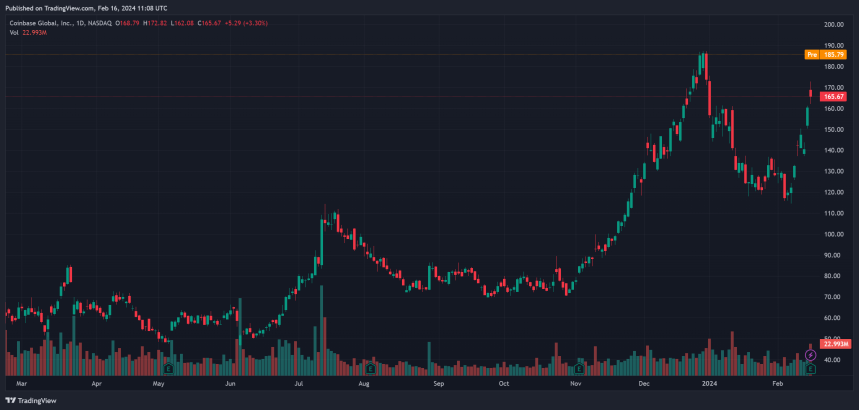
Chart from Tradingview
Strategic Exploit: Crypto Traders Harvested $3 Billion From ‘Kimchi Premium’?
South Korea’s local media, Newsis, recently reported the case of certain crypto traders who had sent about $3 billion overseas in a bid to profit from the ‘Kimichi Premium.’ Interestingly, the court found 14 out of 16 of these traders not guilty despite their alleged actions.
How This Group Of Crypto Traders Operated
These crypto traders are said to have sent these sums of money through local banks under the guise of these transactions being foreign exchange remittances. However, this was allegedly not the case, as they would then use the funds to purchase virtual currencies abroad and send those crypto assets back to domestic exchanges, where they eventually offload them.
This was done to allegedly profit from the ‘Kimichi Premium.’ This phenomenon occurs when crypto assets are more expensive in South Korea than overseas due to the country’s particular regulations.
This has created an arbitrage opportunity that crypto traders have sought to exploit. Meanwhile, the Korean government has tried to prevent traders from doing so.
That is why the prosecution charged 16 people, including someone referred to as Mr. A in the news report, with violating the Specific Financial Information Act. Mr. A and others were accused of illegally transferring foreign currency worth 4.3 trillion won ($3 billion) overseas between April 2021 and August 2022 to exploit the Kimichi premium allegedly.
The prosecution believes these crypto traders made a market profit of as much as 210 billion won ($158 million). In their defense, the defendants argued against any wrongdoing since they weren’t precisely the ones facilitating the foreign exchange business but the bank.
The traders argued they were platform users, not virtual asset business operators. The bank involved also tried to absolve itself from the case as it claimed it carried out the transaction based on the “false evidence” the defendants submitted.
Court Finds The Defendants Not Guilty
The court agreed with most defendants’ arguments, acquitting 14 (including Mr. A) out of the 16 persons charged. A local Judge who ruled over the case opined that their actions didn’t violate the objective of the Foreign Exchange Transactions Act and, therefore, could not be punished under that law.
The Judge added that there was “nothing to suggest that the defendants operated as virtual asset business operators.” If the reverse was the case, they could have been punished for not registering their business or making certain disclosures as required by the law.
Interestingly, Judge Park further distinguished the current case from a Supreme Court precedent as he noted that the highest court did not “explicitly judge the issues in this case.” The prosecution already submitted an appeal, dissatisfied with the court’s ruling.
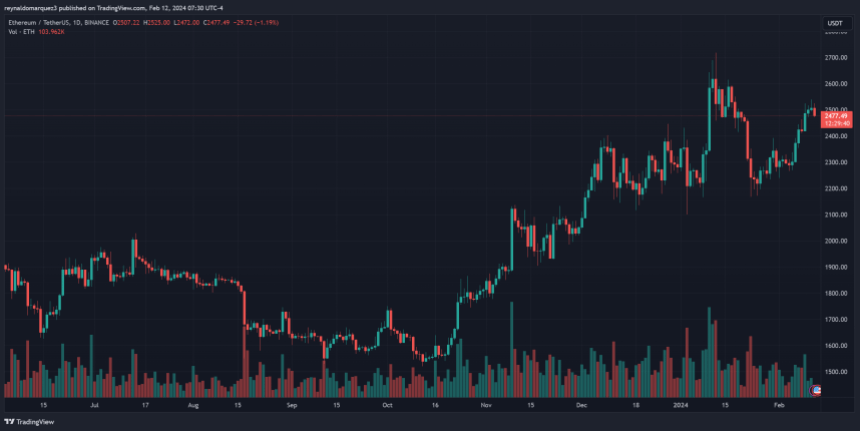
Chart from Tradingview
What Is Sei (SEI) Network?
The Sei (SEI) Network is a Cosmos-based layer-1 blockchain that aims to change the world of digital asset trading, especially in the decentralized exchange (DEX) ecosystem. It was specifically designed for the world of trading, featuring various sectors of the cryptocurrency space spanning GameFi, NFTs, and, most especially, decentralized finance (DeFi). Sei is positioned as the “Decentralized NASDAQ,” as it offers a seamless blend of centralized finance (CeFi) trading experiences with decentralized finance tools.
Since its inception, it has established itself as a major player in the cryptocurrency space by providing cutting-edge features and advantages over rivals. With its innovative technology stats and passionate community, it has become one of the fastest-growing Layer 1 blockchains for trading and other purposes.
At its core, the SEI token is designed to optimize and streamline business operations and interactions. It is expected to be not just a cryptocurrency but a comprehensive solution that addresses several challenges in the contemporary blockchain ecosystem.
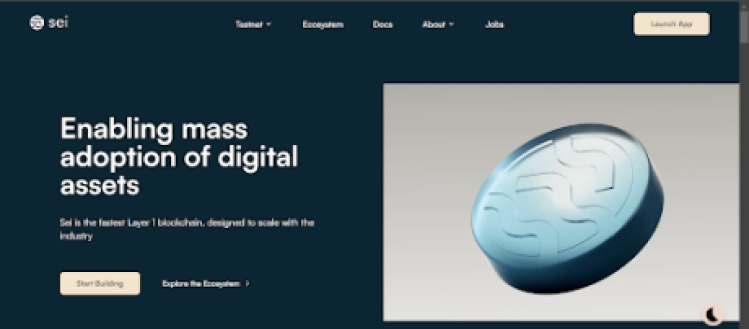
Who Are The Founders Of Sei Network?
Sei (SEI) network founders and brains behind the SEI are Jayendra Jog, Dan Edlebeck, and Jeffrey Feng. Jayendra Jog was the former lead software engineer at Robinhood, a popular centralized crypto exchange.
Dan Edlebeck is the co-founder and CEO of Exidio, a decentralized VPN application in the Cosmos ecosystem. Lastly, Jeffrey Feng brought his investment experience from his role at Goldman Sachs.
Investors And Institutions Backing the SEI Token
The Sei network has a lot of credible investors and institutions backing it, such as Coinbase, which is one of the largest centralized exchanges (CEX) in the world; Jump, Muitcoincapital, Layer Zero, GSR, and many more, as shown in the screenshot from the website below.
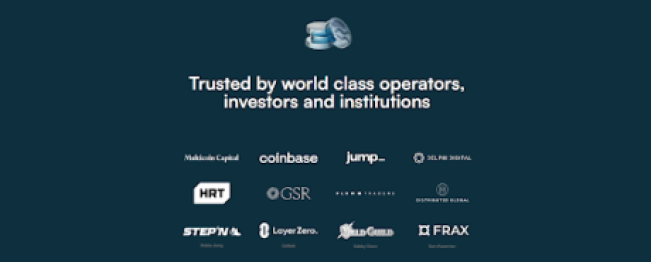
What Sei Network Aims To Achieve In The Crypto Space And Beyond
Sei aims to foster smart, efficient, and sustainable enterprises, and it does so by leveraging the power of blockchain technology to automate processes, reduce costs, and eliminate intermediaries. This makes Sei tokens a frontrunner in the race toward a decentralized future.
Sei token is unique in its approach and functionality as it goes beyond the standard features of cryptocurrencies and offers a sophisticated governance model encouraging active community participation. It takes the decentralization aspect a notch higher by ensuring fair and transparent decision-making.
The token is designed for compatibility and scalability, allowing seamless integration with new and existing business systems. This means whether you are a large corporation like Blackrock, which manages $10 trillion in assets, or a small business startup, the Sei token is designed to fit right into your operations, providing you with the benefits of blockchain without the hassle of overhauling your business system.
How Does Sei (SEI) Work?
One of the major problems with decentralized exchange (DEXs) is that orders are either not processed on-chain or are processed on-chain on a fast blockchain at the expense of decentralization and security.
Given this bottleneck, the Sei network has implemented several innovative features to resolve the challenges faced by decentralized exchanges (DEXs) by combining off-chain speed with on-chain security. It aggregates orders at the end of the block and executes them all at once rather than executing them one at a time, and in this way, it prevents the persistent problem of front-running in decentralized trading.
The Sei network also makes use of native price oracles that minimize external dependencies while offering trustworthy data feeds. It handles the placement and execution order of a single transaction as opposed to doing so in two (2).
What Makes The Network Unique?
The Sei network stands out from the rest due to its self-executing smart contracts with the terms of the agreement directly written into code lines. The code and the agreement contained therein then exist across a distributed blockchain network.
This means that the transactions are irreversible and trackable, and they do not require a third-party intermediary. This automation process drastically reduces costs and increases efficiency, making transactions smooth and very easy.
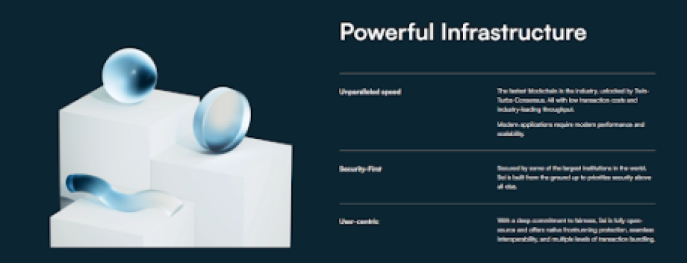
Sei tokens also utilize a decentralized infrastructure, which means any single central entity or authority does not control it. Instead, control is spread out amongst many different nodes or computers that participate in the network to ensure that even if one node goes down, the entire network continues running smoothly.
The decentralized nature of the SEI token fosters a sense of community and mutual trust among its users. It boasts a democratic system that encourages active participation and promotes transparency and fairness.
Notable Features Of The Sei (SEI) Network
Twin-Turbo Consensus Mechanism: The Sei network leverages the Cosmos SDK and Tendermint Core to provide decentralized trading apps with speed, security, capital efficiency, and decentralization.
Parallelization: The Sei blockchain divides work into smaller chunks, processing and executing them simultaneously to prevent front-running.
Native Order Matching: The Native Order Matching feature ensures that decentralized exchanges (DEXes) are able to have their own central limit order book (CLOB).
Order Bundling: Sei offers order bundling at the client and chain level to enhance user experience and efficiency.
Price Oracles: It’s integrated into a native system for trustworthy assets with real-time oracles provided by validators, meaning that Sei provides users with an Oracle module that functions as a token price reference.
Lightning Speed Transactions: Sei claims to offer 600 milliseconds in transaction finality, making it highly scalable compared to other crypto projects like Bitcoin, Ethereum, and even Solana.
Fee Structure: At launch, SEI tokens have no chain-level trading fees; however, decentralized exchanges (DEX) may introduce their transaction fees through smart contracts.
Potential Applications Across Various Industries
Banking and Financial Industry: The Sei blockchain technology is designed to streamline operations, eliminating the need for intermediaries and reducing transaction costs. This will bring a new level of transparency to the banking and financial industry, with every transaction recorded and traceable on the blockchain.
Medical and Healthcare Industry: The Sei network offers an efficient way to manage and share patient data securely. This can help eradicate fraudulent activities, improve patient care, and enhance data interoperability.
Supply Chain (Import and Export) Industry: The Sei blockchain network token can ensure the authenticity and traceability of products, from the raw materials to the end consumers. Every step can be recorded on the blockchain, providing full visibility and reducing the emergence of counterfeit goods and products.
Impact on the Environment: Sei’s eco-friendly consensus mechanism significantly reduces energy consumption compared to traditional cryptocurrency. Its smart contracts can automate carbon credit trading, supporting businesses in their sustainability efforts.
Digital Identities: The Sei network can be employed to develop a secure decentralized solution for managing digital identities and protecting individuals’ privacy and digital data.
The Tokenomics Of SEI Coin
Sei’s native cryptocurrency, SEI, does not have a maximum supply of tokens to be mined. However, it has a total supply of 10 billion coins. This means all of the tokens in circulation have been free-mined on the blockchain, including those that are locked or reserved. The token has a circulating supply of 2.4 billion at the time of publication.
According to its website, 48% of the supply is in an Ecosystem Reserve, with Private Sale Investors and the Team receiving 20% of the supply, respectively. 9% of the supply went to the Sei Foundation and the Launchpool received 3% of the supply.
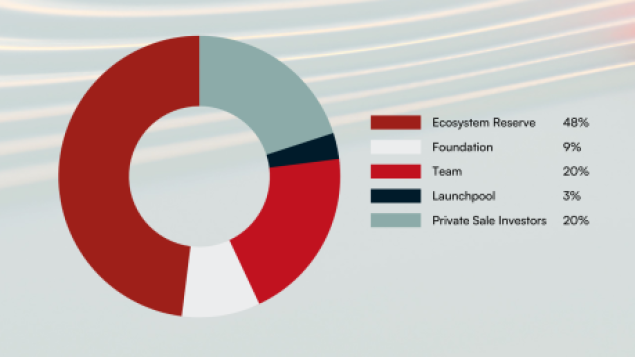
Sei token is up 619% since its all-time low of $0.09536 on October 19, 2023, and its latest all-time high of $0.8778 was recorded on January 3, 2024. With a market cap of $1.5 billion, it is currently the 48th-largest cryptocurrency in the industry.
Conclusion
The Sei network aims to solve issues not only in the crypto industry but also in other industries. This includes the likes of the banking and financial industry, where it aims to reduce the costs of transactions by eliminating the use of intermediaries and providing top-notch security measures to protect user privacy and identities.
The blockchain is energy-efficient compared to the likes of Bitcoin as it doesn’t consume as much energy. Its super-fast 600-millisecond transaction finality makes it highly scalable on a scale comparable to Kaspa, whose full confirmation transactions are at an average of 10 seconds.
How To Buy, Sell, And Trade Crypto Tokens On The Tron Network
The Tron network is a decentralized blockchain platform that aspires to create an expansive and interconnected global digital content ecosystem. At its core, Tron leverages its native cryptocurrency, TRX, to facilitate seamless transactions and interactions within the network.
An outstanding advantage of the Tron (TRX) network lies in its exceptional scalability and impressive transaction processing capacity. This remarkable feature enables Tron to process a substantial number of transactions swiftly, ensuring the smooth execution of smart contracts and decentralized applications (DApps). The network’s scalability is of utmost importance as it plays a vital role in supporting the expansion of its ecosystem and meeting the growing needs of both users and developers.
Tron (TRX) empowers developers to create and launch decentralized applications (DApps) through the integration of smart contracts into its framework. These versatile DApps span across diverse sectors, including finance, gaming, social media, and more. Tron equips developers with essential tools, resources, and support, enabling them to craft cutting-edge and fully operational applications. This fosters a dynamic developer community, driving ongoing expansion and diversification within the Tron ecosystem.
Tron’s emphasis on digital content is a distinguishing feature of the network. It aims to revolutionize the entertainment industry by directly connecting content creators and consumers without the need for intermediaries. The platform empowers creators by enabling them to distribute their content and monetize it through direct interactions with their audience.
The network (TRON) relies on a delegated proof-of-stake consensus mechanism for its security. Validators in the network are rotated every six hours, chosen by users who stake their TRX tokens.
To combat software bugs, Tron involves its community through the Bug Bounty Program. Users can contribute to development and earn rewards by reporting bugs and vulnerabilities. The Tron Foundation generously provides TRX rewards as an incentive, fostering a collaborative environment for network security.
This article delves into the fundamental features of the TRON network and explores its significant potential within the TRON ecosystem while also providing guides on how to buy, sell and trade on the network.
Features Of The TRON Network
Delegated Proof-of-Stake (DPoS) Consensus: The DPoS is a consensus mechanism utilized by the TRON network to enable its users to vote for representatives responsible for validating transactions and securing the network. This system guarantees swift transaction confirmation and streamlined network operations, enabling scalability and suitability for high-demand applications.
Smart Contracts and DApps: TRON offers a platform for the creation and implementation of smart contracts, which are self-executing agreements governed by predetermined rules. These smart contracts serve as the foundation for developing decentralized applications (DApps) that automate processes, enhance peer-to-peer interactions, and introduce trailblazing functionalities in sectors including finance, gaming, social media, and more.
Developer-Friendly Environment: TRON fosters a developer-friendly ecosystem by equipping developers with essential tools, resources, and support to build innovative and functional DApps. It offers user-friendly programming languages, software development kits (SDKs), and comprehensive documentation to optimize the development process. This commitment to developers encourages a vibrant community, promotes collaboration, and fuels ongoing growth and diversification within the TRON ecosystem.
Scalability and Throughput: One of the main purposes of the TRON network is that it is purposefully built to efficiently process a substantial number of transactions with exceptional throughput. Its infrastructure facilitates swift transaction execution, ensuring seamless operations for smart contracts and decentralized applications (DApps). This scalability plays a vital role in meeting the increasing adoption and requirements of users and developers.
Global Accessibility: TRON’s decentralized architecture guarantees worldwide accessibility, enabling individuals from across the globe to engage with the network. The platform’s infrastructure is intentionally designed to be accessible to anyone with an internet connection, promoting inclusivity and fostering a digital ecosystem without any geographical boundaries.
Direct Creator-Consumer Interaction: TRON enables content creators to engage directly with their audience without intermediaries. This direct connection fosters a more intimate and transparent relationship, allowing creators to better understand their audience’s preferences and tailor their content accordingly.
Ownership Rights: TRON acknowledges the significance of content ownership for creators and leverages the immutability and transparency of blockchain technology to safeguard their intellectual property rights. By doing so, TRON empowers creators to retain control over their content and ensures they are duly compensated for its utilization.
Monetization Opportunities: TRON empowers content creators by enabling them to directly monetize their content. By leveraging smart contracts and digital tokens, creators can receive payments directly from their audience, bypassing the need for third-party payment processors. This direct monetization approach allows creators to retain a greater share of their earnings and exert more control over their revenue streams.
How To Get Started On The Tron Network
To buy and sell tokens on the TRON network, you will first need to get a TRON-compatible wallet like Tronlink. In this article, we will give examples using Tronlink. It is a popular TRON wallet extension and is readily accessible on leading browsers such as Google Chrome.
Related Reading: How To Buy, Sell, And Trade Tokens On The Optimism Network
With TronLink, users can effortlessly create and oversee TRON wallets, securely store TRX, as well as other TRC-10/TRC-20 tokens, and seamlessly engage with TRON DApps, all within the convenience of their browser interface.
To add your TronLink Wallet as a browser extension, simply click on the “Add to Chrome” icon located in the top right corner, as demonstrated below. This step will ensure that your TronLink Wallet becomes seamlessly accessible within your browser.
Once installed and set up, Open the TronLink extension in your browser. You will be prompted to either create a new wallet or import an existing one. If you’re new to TronLink, select the option to create a new wallet and follow the instructions to set up a password.
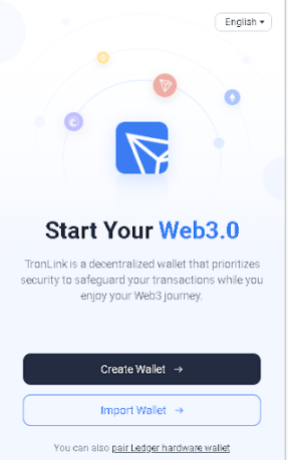
It is imperative to back up your wallet to ensure you can recover your funds in case of any unforeseen circumstances. TronLink will provide you with a unique set of recovery phrases during the wallet creation process. Write down and securely store these phrases in a safe place. (Do not store it on your device).
Trading On The TRON Network
The Tron network is capable of supporting various decentralized applications. Tron is often used to transact, as TRX transactions come with very low fees.
In order to engage in trading activities on the TRON network, it is essential to have TRX tokens in your wallet. TRX serves as the native cryptocurrency of the TRON network and is indispensable for executing trades, interacting with decentralized exchanges, and participating in decentralized finance (DeFi) protocols.
Hence, prior to initiating any trading or transactions on the TRON network, it is crucial to ensure that your wallet is adequately supplied with TRX tokens.
The next step is to fund your wallet. You can add TRX or other TRC-10/TRC-20 tokens to your TronLink wallet. Click on the “Receive” button in your Tronlink wallet to generate a wallet address; tokens will be available in your wallet almost immediately.
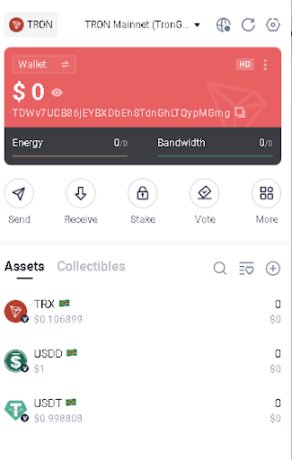
You can obtain TRX using popular cryptocurrencies like Bitcoin (BTC) or Ethereum (ETH) from cryptocurrency exchanges like Binance and transfer it to your TronLink wallet address.
Note that users can also access various DEXs interfaces like SunSwap through their Tronlink wallet by clicking on the “More” button in the same row as the “Receive” button.
How To Buy and Sell Tokens Using SunSwap
SunSwap is a decentralized trading protocol built on the TRON network, with the objective of facilitating automated liquidity provision and establishing an inclusive financial market accessible to all users. By utilizing the decentralized nature of blockchain, SunSwap enables users to participate in liquidity provision by depositing their TRON-based tokens into liquidity pools.
To protect your wallet from malicious activity, ensure that you are on the correct SunSwap website. To get started, visit the correct SunSwap website and click on the “Connect Wallet” option at the top left corner, as in the image below:
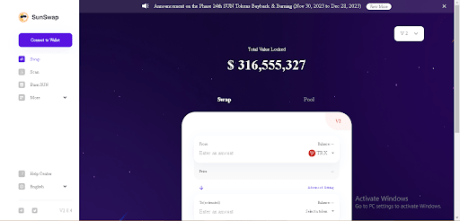
Then, select your preferred wallet (In this case, Tronlink):
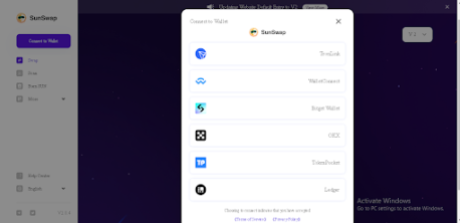
Once connected, Users can commence trading activities as SunSwap is automatically linked to the TRON networks because it is a TRON-based DEX.
After accessing the SunSwap interface, the next step is to select the tokens you want to trade. SunSwap operates on a system where you can exchange your TRON-based tokens directly with other tokens.
Click on the “Select token” button to select the trading pair you want to trade against.
For example, if you want to buy USDT using TRX, select TRX – USDT, enter the amount, then click on “swap” or “trade now” and then you can go to your Tronlink wallet to confirm the transaction.
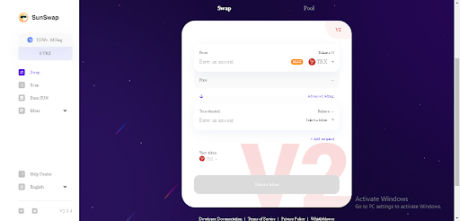
Tracking Token Prices on The TRON Network
Avedex is a powerful on-chain tool for TRON network users, offering comprehensive market insights for specific tokens. It provides valuable information such as price data, contract details, and advanced analytics tools. Traders can analyze price trends, liquidity, and token fundamentals to make informed trading decisions.
Additionally, Avedex allows for token comparison, user reviews, and rating systems, enhancing the decision-making process. With integration to TRON wallets and notification features, Avedex streamlines the trading experience, enabling users to stay updated and act promptly.
Related Reading: Celestia Network: How To Stake TIA And Position For 5-Figure Airdrops
Overall, Avedex empowers TRON traders with reliable information and tools to navigate the market effectively and make well-informed trading choices.
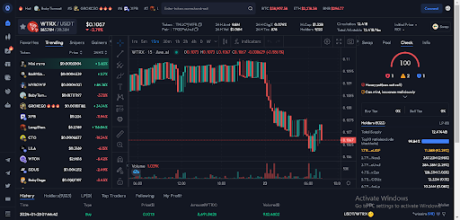
Conclusion
In conclusion, the TRON (TRX) network offers a decentralized blockchain platform that prioritizes the creation of a global digital content ecosystem. With its scalable infrastructure and high transaction processing capacity, TRON enables the swift execution of smart contracts and decentralized applications (DApps) across various sectors. The network’s developer-friendly environment provides essential resources and support for developers to build innovative DApps, fostering a vibrant community within the TRON ecosystem.
To engage with the TRON network, users need a TRON-compatible wallet like TronLink. They can obtain TRX tokens from various popular exchanges, transfer them to their TronLink wallet, and then trade on platforms like SunSwap for decentralized trading.
Overall, the TRON network offers a robust ecosystem for buying, selling, and trading tokens, while its focus on digital content and developer support makes it an attractive platform for creators and users alike.
How To Buy, Sell, And Trade Tokens on The Polygon Network
Polygon (formerly Matic Network) is a game-changing Layer 2 scaling solution that addresses Ethereum’s scalability challenges. It empowers developers to create and deploy scalable, interoperable decentralized applications (dApps) by utilizing sidechains, plasma chains, and innovative scaling techniques.
If you’re unfamiliar, sidechains are unique blockchains that are bound to the main Ethereum blockchain and are effective in supporting many Decentralized Finance (DeFi) protocols available on the Ethereum network. This enables rapid transaction speed and cost-effectiveness while maintaining the security and decentralization of the Ethereum network.
As a Layer 2 solution, Polygon operates in parallel to the Ethereum blockchain. Rather than individually validating each transaction, batches of transactions are sent to the Ethereum blockchain, significantly accelerating the validation process and reducing fees.
Polygon implements a proof-of-stake consensus mechanism wherein users can stake tokens for a predetermined duration to validate transactions. In return for their staking activities, participants are rewarded with MATIC tokens.
To ensure robust security, Polygon implements the advanced technique of “commit-chain” or “checkpointing.” It securely anchors the state of Polygon chains onto the Ethereum mainnet at regular intervals, enhancing data integrity and leveraging Ethereum’s inherent security. By capitalizing on Ethereum’s proven security measures, Polygon provides users with a reliable and resilient platform for their transactions and dApps.
The Polygon Network offers a comprehensive set of features that address scalability, security, and developer-friendliness. In this article, we will delve into the key attributes of the Polygon network and assess its substantial potential within the Ethereum ecosystem.
Features Of The Polygon Network
Cross-Chain Connectivity
Polygon network offers bridges that enable smooth transfers of assets and data across diverse blockchains. This fosters interoperability between chains, empowering users to leverage the advantages of multiple blockchain networks and access a broader array of decentralized finance (DeFi) protocols and applications.
Polygon presents a Layer 2 scaling solution for Ethereum by leveraging sidechains to address scalability challenges. This solution facilitates quicker and more economical transactions, alleviating congestion and mitigating high fees on the Ethereum network
Ethereum Compatibility
Polygon seamlessly integrates with the Ethereum Virtual Machine (EVM), enabling developers to effortlessly migrate their existing Ethereum decentralized applications (dApps) to the Polygon network. This compatibility guarantees a seamless transition and adoption of Polygon while leveraging the extensive Ethereum ecosystem and developer tools.
Commit-Chain Checkpointing
Polygon employs commit-chain checkpointing, securing the state of its chains by anchoring them onto the Ethereum mainnet. This approach guarantees the integrity of data, harnesses Ethereum’s robust security measures, and safeguards against any unauthorized alterations or tampering of the sidechain data.
Ethereum Network Security
Leveraging Ethereum as its anchor chain, Polygon leverages the inherent security and decentralization of the Ethereum network. This integration fortifies the overall security of the Polygon ecosystem, ensuring users have access to a reliable and resilient platform for transactions and decentralized applications (dApps).
Developer-Centric Environment
Polygon provides an array of developer tools and infrastructure that empower developers to create and deploy decentralized applications (dApps) seamlessly. The Polygon Software Development Kit (SDK) offers a streamlined framework for building scalable applications on the network, simplifying the development process.
Polygon also prioritizes the needs of developers by offering extensive documentation, guides, and resources. This ensures that developers have access to the necessary information and support to comprehend and harness the platform effectively. The availability of comprehensive resources fosters a vibrant developer community, encouraging collaboration and driving innovation on the network.
MATIC Token Utility And Exchange Availability
Polygon’s rebranding decision resulted in the retention of MATIC as its token ticker symbol. MATIC, an ERC-20 token, ensures compatibility with numerous Ethereum projects. Within the Polygon network, users rely on MATIC to secure and govern the network and cover transaction fees.
The MATIC token serves multiple purposes within Polygon’s ecosystem. Users can utilize MATIC for fee payments during transactions on the Polygon platform. MATIC can also be staked to contribute to the network’s security and earn rewards.
Furthermore, MATIC holders have the ability to engage in governance activities by voting on proposed modifications, influencing the evolution of the network.
In terms of exchange availability, MATIC can be traded on various platforms, including prominent exchanges like UniSwap. This wide accessibility on exchanges enhances liquidity and provides individuals with convenient access to acquire or trade MATIC tokens.
How To Get Started On The Polygon (MATIC) Network
To engage in token transactions on the Polygon network, users must acquire a MetaMask wallet. MetaMask, a widely used browser extension wallet, provides a seamless interface for interacting with blockchain networks, including Ethereum. This user-friendly wallet is accessible as a browser extension for popular browsers like Google Chrome.
To ensure your MetaMask Wallet is added to your browser as an extension, click on the ‘Add to Chrome’ icon located at the top right corner, as depicted below:
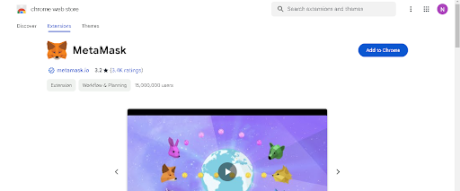
After installation and setup, MetaMask enables users to effectively manage their cryptocurrency wallets, seamlessly interact with decentralized applications (DApps), and securely execute transactions on supported blockchain networks, all directly from within their web browsers.
Remember to diligently write down your seed phrase on a physical sheet of paper and store it in a secure location. Avoid storing it online or on any electronic device to ensure maximum security.
For the next step, add the Polygon (MATIC) network to your Metamask wallet by following the instructions provided on the Metamask website here.
Trading On The Polygon (MATIC) Network
In order to execute trades on the Polygon (MATIC) network, you will need to fund your wallet with MATIC so as to enable you to cover gas fees. These fees cover the expense associated with utilizing computational resources related to transaction processing and validation.
To purchase MATIC tokens, you can utilize centralized exchanges like Binance. Simply copy your wallet address from MetaMask and proceed to transfer MATIC tokens from your Binance account to your MetaMask wallet.
In addition, it is possible to acquire MATIC directly within the MetaMask wallet by utilizing conventional payment methods such as credit or debit cards and other similar options.
Simply click on the “Buy/Sell” button within the MetaMask interface to access the designated section. Within this interface, you can specify the desired amount of MATIC (or any other token) you wish to purchase in terms of US dollars. Additionally, you can select your preferred payment method before finalizing the transaction by clicking on the “Buy” button.
It’s imperative for users to be aware that when purchasing cryptocurrencies directly within MetaMask, you will be required to provide information such as your country and state. However, rest assured that this process is simple and can be completed within a minute.
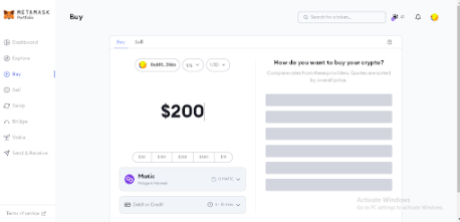
You can expect your MATIC tokens to arrive in your wallet within a few minutes at most. Once they have arrived, you are ready to start trading tokens on the Polygon network. To begin your trading journey, navigate to UniSwap and commence your trading activities.
How To Trade Tokens On The Polygon Network Using UniSwap
Uniswap is an Ethereum blockchain-based decentralized exchange (DEX) protocol that enables users to trade Ethereum-based tokens from their wallets directly, eliminating the necessity for intermediaries or conventional order books. Uniswap provides users with a hassle-free method to purchase and sell various tokens.
To safeguard your wallet against fraudulent activity, ensure that you are accessing the legitimate Uniswap website.
Begin by clicking on the “Launch App” button located in the top right corner, as depicted in the image below:
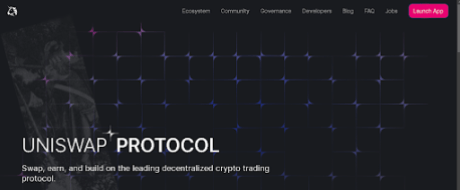
Next, proceed by selecting the “connect” option located at the top right corner of the UniSwap interface, as depicted in the provided image below:
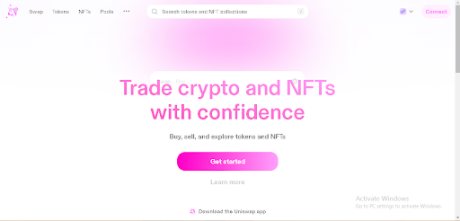
Establish a connection with your preferred wallet, as shown in the image below. In this instance, the suggested wallet is Metamask:
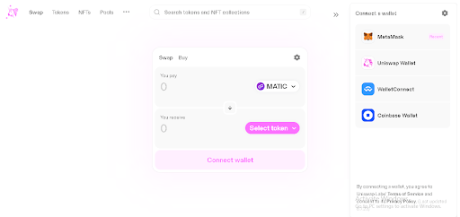
After establishing the connection, adjust your Metamask settings to the Polygon (MATIC) network. (If you are already connected to the Polygon network, there is no need to make any network switches).
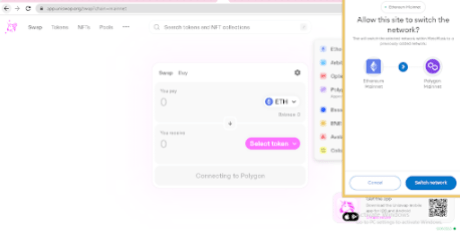
Once you have successfully connected MetaMask to the Polygon network, navigate to UniSwap to begin trading on the Polygon network through the platform.
Moving forward, you need to choose your desired tokens within the UniSwap interface. As Uniswap operates on a token-to-token trading model, click on the “Select Token” button to designate the specific trading pair you wish to trade against.
To illustrate, if you intend to purchase USDT using MATIC, simply choose the MATIC – USDT trading pair, specify the desired amount, and click on “Swap” or “Trade Now.” Confirm the transaction in your Metamask wallet, and you will be able to view the tokens in your wallet’s asset list.
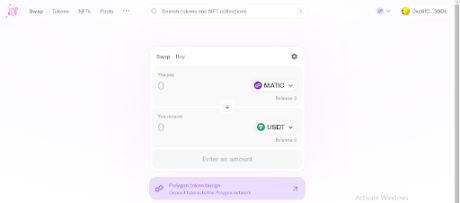
Buying And Selling Tokens With Metamask
Metamask extension wallet, connected to the Polygon network, allows users to buy and sell tokens seamlessly. To proceed, ensure that you are connected to the Polygon network and possess MATIC tokens for swapping and covering gas fees.
Then, locate the “Swap” button, as illustrated below. Clicking on it will direct you to the Swap interface within the Metamask wallet.
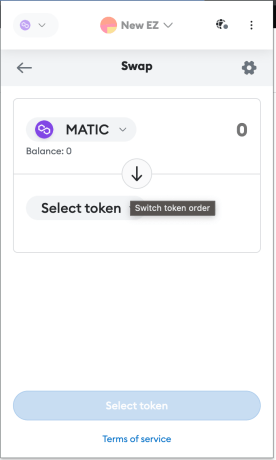
Using the image above as a guide, users can search for tokens by name or contract address, just like on UniSwap. Enter the amount of MATIC you want to swap, make sure you have the correct token, and click on “Swap”. Once the transaction is confirmed, the tokens you bought will be sent to your wallet.
Tracking Token Prices on The Polygon Network
Polygon network users can equip themselves with potential on-chain tools like Dexscreener, which opens up a world of new opportunities for traders. Dexscreener provides users with extensive market insights for specific tokens, ranging from real-time price data to in-depth contract information. It also helps users make well-informed trading decisions based on reliable and up-to-date data.
Stay ahead of the curve on the Polygon network with Dexscreener, keeping track of token metrics and market dynamics.
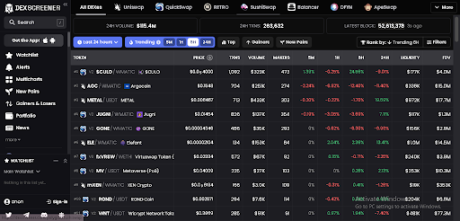
Dexscreener on the Polygon network offers invaluable features tailored to users. One standout feature is its charting functionality, which provides real-time and historical price data for various tokens.
By utilizing these charts, users can gain valuable insights into price trends, trading volumes, and other important metrics.
Check below for a visual representation:
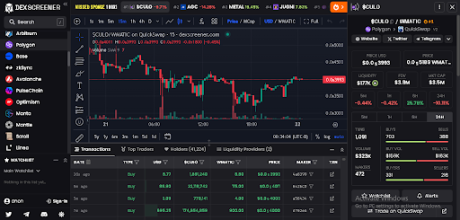
Conclusion
The Polygon network provides a robust and user-friendly environment for traders to thrive. With its innovative features, growing ecosystem, and commitment to scalability, Polygon is poised to play a pivotal role in shaping the future of decentralized finance.
As Polygon continues to experience growth and wider adoption, we anticipate a broader selection of applications and services tailored to meet the diverse requirements of traders. The network’s dedication to scalability, interoperability, and user satisfaction establishes it as a frontrunner in the ever-evolving blockchain industry.
How To Buy Sell and Trade Tokens On The Arbitrum Network
The Arbitrum (ARB) network is a Layer 2 scaling solution for Ethereum that aims to address the scalability and high transaction fees. It is developed by Offchain Labs and utilizes a technology called Optimistic Rollups to achieve its objectives.
Optimistic Rollups work by processing most transactions off-chain and then periodically submitting a summary of those transactions to the Ethereum mainnet. This approach reduces the transaction costs significantly and increases the throughput of the network while maintaining the security guarantees of the Ethereum mainnet.
In other words, the optimistic rollup feature allows Ethereum smart contracts to scale by passing messages between smart contracts on the Ethereum main chain and those on the Arbitrum second layer chain. Much of the transaction processing is completed on the second layer, and the results of this are recorded on the main chain — drastically improving speed and efficiency.
One of the key features of the Arbitrum network is its compatibility with existing Ethereum smart contracts. Developers can deploy their contracts on the Arbitrum network with minimal modifications, allowing for easy migration of decentralized applications (dApps) from Ethereum to Arbitrum.
Also, the arrival of the Ethereum network introduced a groundbreaking transformation in the realm of blockchain technology, providing a platform for the creation of decentralized applications (dApps) and propelling the growth of decentralized finance (DeFi). Nevertheless, as Ethereum’s preeminence soared, it encountered hurdles related to scalability and exorbitant transaction fees.
This is where the Arbitrum network enters the picture as a Layer 2 scaling solution, poised to tackle these challenges while ensuring seamless integration with Ethereum’s ecosystem. In this article, we will explore the core features of the Arbitrum network and examine its immense potential in the Ethereum ecosystem.
Features Of Arbitrum Network
The promise of Scalability:
Scalability has long been a bottleneck for Ethereum, causing network congestion and skyrocketing transaction fees during times of high demand. Arbitrum tackles this challenge by implementing Optimistic Rollups, a technology that allows for most transactions to be processed off-chain. By aggregating multiple transactions into a single summary, ARB achieves significant scalability improvements, enabling faster confirmation times and a higher throughput. This scalability boost unlocks the potential for a more efficient and seamless user experience on the Ethereum network.
Ecosystem and Adoption:
The Arbitrum network has garnered significant attention and interest within the Ethereum ecosystem. Several prominent projects and protocols have announced plans to deploy on Arbitrum or explore integrations. This growing ecosystem includes decentralized exchanges (DEXs), lending platforms, gaming applications, and more.
The increased adoption of Arbitrum provides users with a wider range of options for interacting with decentralized applications (DApps) and accessing various DeFi services.
Smart Contract Execution:
Arbitrum Network makes use of a technique called optimistic execution to process smart contracts. It assumes that most transactions are valid and executes them off-chain. This enables the network in providing fraud proofs, which allows anyone to challenge invalid transactions by submitting evidence to the Ethereum mainnet. This approach enables efficient and secure smart contract execution.
Decentralization and Security:
While Arbitrum relies on the Ethereum mainnet for final settlement and security, it maintains a high level of decentralization and security. By leveraging Ethereum’s robust consensus mechanism, Arbitrum benefits from the security guarantees of the Ethereum network. The periodic submission of transaction summaries to Ethereum ensures that any potential fraudulent activity can be detected and resolved.
Seamless User Experience:
Using the Arbitrum(ARB) network is designed to be seamless for users. They can continue using their existing Ethereum wallets, such as MetaMask, to interact with the Arbitrum network. This familiarity and compatibility make it easier for users to transition from Ethereum to Arbitrum and enjoy the benefits of improved scalability and reduced transaction fees without significant changes to their workflows.
What Makes Arbitrum Unique?
The Arbitrum (ARB) network is designed to provide an easy-to-use platform developers can use to launch highly efficient and scalable Ethereum-compatible smart contracts. It offers a range of exciting possibilities for developers and users alike. Some examples of what can be done on the network include:
High EVM compatibility
Arbitrum(ARB) is considered to be one of the most EVM-compatible rollups. It’s compatible with the EVM at the bytecode level, and any language that can compile to EVM works out of the box — such as Solidity and Vyper. This makes it easy to build on since developers do not need to get to grips with a new language before building on Arbitrum.
Decentralized Finance (DeFi) applications:
The Arbitrum (ARB) network can be used to build and run DeFi applications, such as decentralized exchanges (DEXs), lending and borrowing platforms, and stablecoin systems. These applications can benefit from the network’s fast transaction processing times and low gas fees, enabling efficient and affordable transactions.
Low transaction fees
As a Layer 2 scaling solution for Ethereum, Arbitrum isn’t just designed to boost Ethereum’s transactional throughput, it also minimizes transaction fees at the same time.
Thanks to its extremely efficient roll-up technology, Arbitrum is able to cut fees down to just a tiny fraction of what they are on Ethereum, while still providing sufficient incentives for validators.
Well-developed ecosystem
Arbitrum is already working with a wide variety of Ethereum DApps and infrastructure projects, including the likes of Uniswap.
Cross-Chain Interoperability
The Arbitrum (ARB) network can also be used to enable cross-chain interoperability between different blockchains. This could allow for the seamless transfer of assets and data between different blockchain ecosystems, enabling greater interoperability and connectivity across the entire blockchain space.
The Arbitrum network’s fast transaction processing times, low fees, and security and decentralization features make it a compelling choice for a wide range of use cases.
How To Get Started on The Arbitrum Network
To buy and sell tokens on the Arbitrum (ARB) network, you must first get a metamask wallet. MetaMask is a popular browser extension wallet commonly used for interacting with blockchain networks like Ethereum. It is available as a browser extension for popular browsers such as Google Chrome.
Ensure your Metamask Wallet has been added to your browser as an extension by clicking on the ‘Add to Chrome” icon on the top right as shown below:
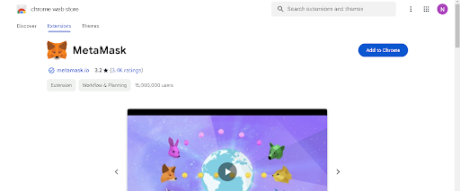
Once installed and set up, MetaMask allows users to manage their cryptocurrency wallets, interact with decentralized applications (DApps), and securely execute transactions on supported blockchain networks directly from their browsers. (Make sure to write down your seed phrase on a piece of paper and keep it in a safe place. Do not store it online or on your device).
Next, add the ARB network to your Metamask wallet by following the instructions provided on the Metamask website here.
Trading On the Arbitrum (ARB) Network
In order to execute trades on the ARB network, you will need to fund your wallet with Ethereum (ETH) so as to enable you to cover gas fees even though the majority of the trading activity takes place on the Arbitrum layer 2 solution. This is because the Arbitrum network periodically submits transaction summaries and proofs to the Ethereum mainnet, which requires paying Ethereum gas fees.
You can buy ETH on centralized exchanges such as Binance, copy your wallet address from Metamask, and then send the ETH from Binance to your Metamask wallet.
You can also purchase ETH directly within the Metamask wallet using traditional payment methods such as credit or debit cards, etc.
Just click on the “Buy/Sell” button within Metamask to open the interface. Here, you can put how much ETH (or any other token) you want to buy in terms of dollar terms, pick your payment method, and then click “Buy”.
Note that to buy crypto directly within Metamask, you will need to provide info such as your country and state. However, it is a straightforward process that only takes a minute.
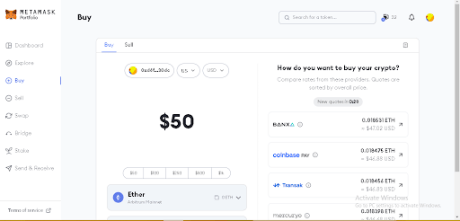
It’ll only take a couple of minutes at most for your ETH to arrive in your wallet. Once the ETH arrives, you are all set to begin trading tokens on the ARB network. So, head over to UniSwap to get started on your trading journey.
How To Trade Tokens On The ARB Network Using UniSwap
Uniswap is a decentralized exchange (DEX) protocol built on the Ethereum blockchain. It allows users to trade Ethereum-based tokens directly from their wallets without the need for intermediaries or traditional order books. Uniswap offers users a simple and straightforward way to buy and sell a wide variety of tokens.
Endeavour to be on the right Uniswap website to protect your wallet from any fraudulent activity. The first step is clicking on the “launch app” button at the top right corner, as shown in the image below:
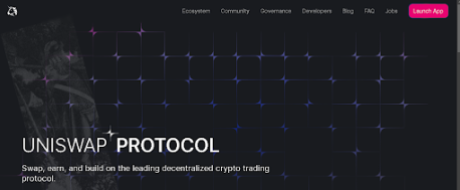
The next step is clicking on the connect wallet option on UniSwap at the top right corner, as shown in the image below:
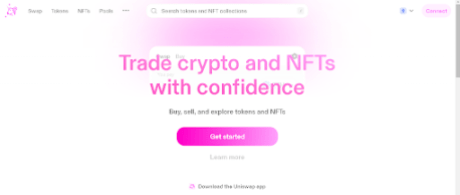
Connect to your preferred wallet as shown below. (In this case, it’s Metamask):
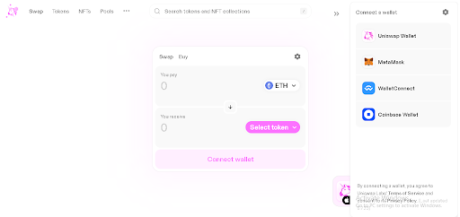
Once connected, switch Metamask to the ARB network. (If you’re already on the ARB network, you do not need to switch):
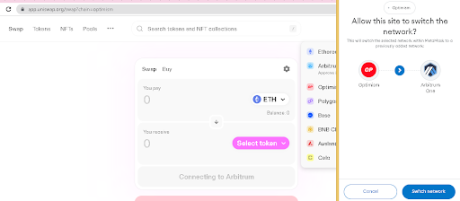
After connecting MetaMask to the ARB network, go to UniSwap, and then you can start trading on the ARB network using UniSwap.
The next step is to select your preferred tokens on the UniSwap interface and since Uniswap operates on a token to token trading model, click on the “select token” button to select the trading pair you want to trade against.
For example, if you want to buy USDT using ETH, select ETH – USDT, enter the amount, then click on “swap” or “trade now” and confirm the transaction in your Metamask wallet. You can view the tokens in your wallet’s asset list.
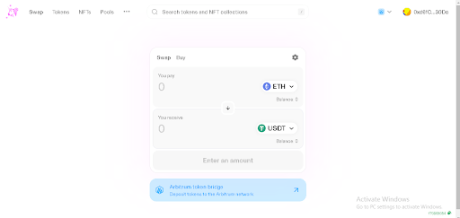
Buying and Selling Tokens with the Metamask Wallet
ARB Network users can also buy and sell tokens using the Metamask extension wallet already connected to the ARB network.
To do this, make sure you’re connected to the ARB network and have ETH to swap and pay for gas fees. Then, navigate to the “Swap” button as shown below. This will take you to the Swap interface inside Metamask.
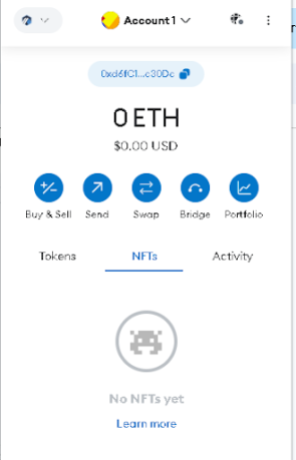
Using the image above as a guide, you can also search for tokens using the name or the contract address, just like on UniSwap. Input the amount of ETH you want to swap, confirm that you have the correct token, and then click “Swap.” Once the transaction is confirmed, the tokens you just bought will be sent to your wallet.
Tracking Token Prices on The Arbitrum Network
Users of the Arbitrum (ARB) network can take advantage of on-chain tools like Dexscreener to gain access to comprehensive market insights for specific tokens. These insights include price data and contract information, empowering users to make well-informed trading decisions based on reliable and up-to-date information.
With Dexscreener on the Arbitrum network, users can stay informed about token metrics and market dynamics, enhancing their trading strategies and overall trading experience.
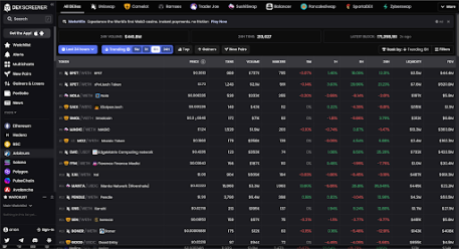
Dexscreener offers a variety of advantageous features tailored to users on the Arbitrum network. Among these features, an exceptional one is the charting functionality, which delivers both real-time and historical price data for a wide range of tokens.
By utilizing these charts, users gain valuable insights into price trends, trading volumes, and other pertinent metrics. This enables them to pinpoint potential entry or exit points for their trades with precision and confidence.
Take a look at the example below:
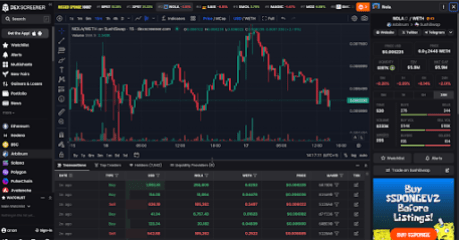
Conclusion
In conclusion, the Arbitrum network offers a compelling ecosystem for buying, selling, and trading tokens, providing several notable advantages over other platforms. With its seamless integration of on-chain tools like Dexscreener, users gain access to detailed market insights, real-time price data, and historical charts, enabling them to make informed trading decisions with confidence.
Additionally, Arbitrum’s scalability and low transaction fees enhance the overall trading experience, ensuring quicker and more cost-effective transactions. By leveraging the power of the Arbitrum network, traders can enjoy a secure, efficient, and feature-rich environment that empowers them to navigate the world of token trading with ease.
China’s Illegal Crypto Activities Are Taking Place in Laundromats and Cafes: WSJ
Physical trading is most popular in China’s inland, as places further from the coast are generally poorer so local governments are preoccupied with other matters.
Crypto Exchanges Trading Volume Hit $10.3T in 2023, New Data Shows
CoinGecko’s 2023 Annual Crypto Industry Report has been released. It covers crypto exchanges and their current state, Bitcoin’s +155.2% and Ethereum’s +90.5% growth, analyzing NFT trading volume throughout the year, and more.
Among the report’s highlights is the comprehensive review of the crypto trading volume in 2023 through the performance of centralized crypto exchanges (CEX) and decentralized exchanges (DEX).
Centralized Crypto Exchanges Dominated
Crypto saw a $36.6 trillion trading volume in 2023, with a volume increase of +53.1% from Q3 ($6.7 trillion) to Q4 ($10.3 T). The Q4 increase marked the first quarter-on-quarter (QoQ) growth of 2023 and could be attributed to the “growing bullish sentiment” in the crypto market due to the anticipation of spot Bitcoin ETFs’ approval by the SEC.
Despite the market’s challenges, such as the aftermath of FTX’s collapse, the worldwide banking crisis, or Binance’s regulatory difficulties in 2023, the data presented in the report shows an overall market recovery.
In December 2023, the trading volume increased sharply to $4.3 trillion, a volume not seen since March 2023. Overall 2023, centralized exchanges dominated the year despite the challenges, especially when compared to decentralized exchanges (DEX). The report details:
- CEXto DEX spot trading volume ratio hovered around 91.5% in Q4.
- CEX to DEX derivatives trading volume ratio dropped to 97.3% from 98.5%.
- CEX to DEX spot ratio stood at 91.4% in 2023.
- CEX to DEX derivatives ratio was 98.1% in 2023.
Binance, Upbit, OKX, Bybit, and Coinbase are among the Top 10 centralized exchanges by trading volume. Binance managed to dominate the list despite dropping to a yearly low market share of 41% in November, following a continued loss throughout 2023.
There was a +98.1% increase QoQ, after the top 10 CEXes recorded $2.20 trillion in spot trading volume in 2023 Q4. Previously, the trading volume had failed to reach above $2 trillion for two consecutive quarters.
Altogether, the top 10 CEXes recorded $7.2 trillion in spot trading volume in 2023 compared to $9.4 trillion in 2022, representing a -23.4% year-on-year (YoY) decline.
Deep Dive Into The Spot Decentralized Exchanges (DEX) Trading Volume In 2023
The Top 10 DEXes recorded $205.3 billion in spot trading volume in 2023 Q4, indicating a +87.1% Total Trading Volume Increase QoQ. Uniswap, Pancakeswap, Orca, Curve, and THORSwap dominate the DEXes in 2023’s Top 10 spot DEX trading volume.
Notably, the report names Orca and THORSwap as the biggest gainers amongst the DEXes in 2023 Q4, with Orca increasing 1,079% ($12.2 billion), while THORSwap saw a surge of 422.4% ($10.1 billion)
When breaking down the 2023 spot DEX trading volume breakdown by chain, the report details that Ethereum had $99.3 billion of DEX trading volume in 2023 Q4, displaying an increase of +38.3% from 2023 Q3. However, it ended with a low 41% dominance, dropping below 50% for the first time in 2023 in November and December.
It’s worth noting that Solana was the biggest gainer, with a 985.5% increase in QoQ, while THORChain took second place with a 422.4% trading volume increase in Q4. The data shows that the two chains ranked #3 and #5 in December 2023.
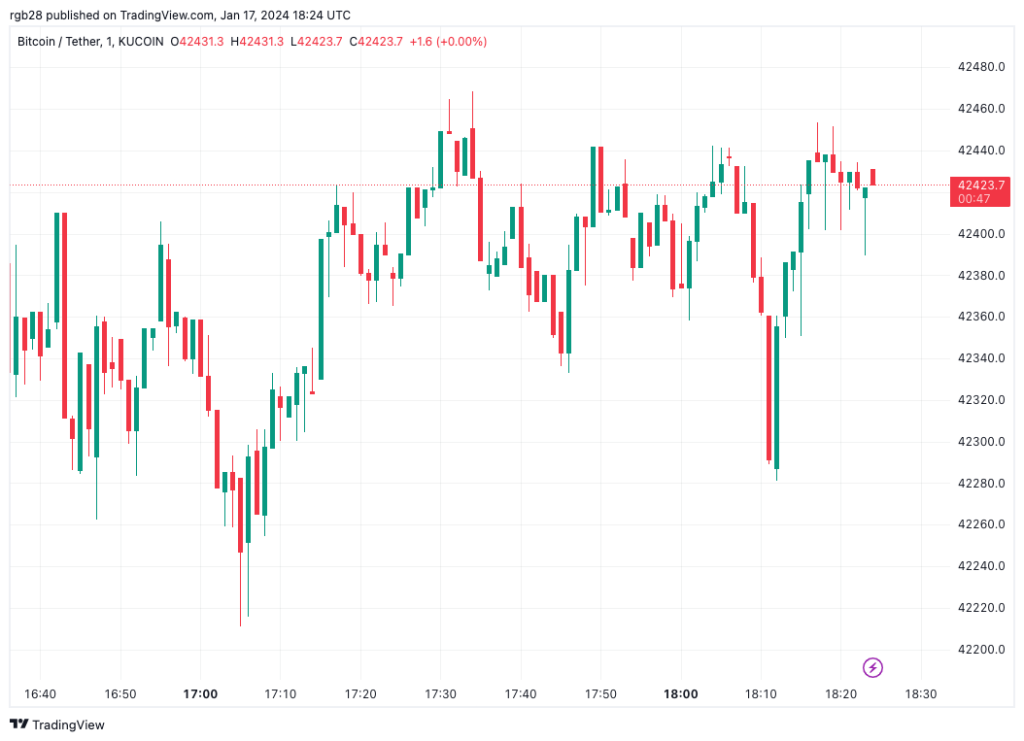
How To Buy And Trade Tokens On The SEI Network
In the dynamic trading world where time is of the essence and you are looking for a combo of speed and low fees, the SEI Network is the fastest decentralized Cosmos-based L1 blockchain that is trading-based with the availability of decentralized exchanges (DExs).
The SEI Network has been optimized to handle large volumes of transactions quickly and efficiently while keeping costs low. This makes it an attractive option for businesses and individuals looking to exchange value in a fast, efficient, and cost-effective manner.
The network has an in-built order book that allows smart contracts to easily access shared liquidity. This shared liquidity feature makes it possible for smart contracts to interact with each other and exchange value without third-party interference.
The way SEI is structured makes it possible for decentralized exchanges and trading applications in areas such as DeFi, NFTs, and gaming to provide the best possible user experience.
In this easy-to-follow guide, we will explore the main features of the super-fast SEI Network, how to set up a trading account, and the different ways to obtain and trade the SEI token. By the end of this guide, you will have a good understanding of how the SEI Network works, its advantages, and how to get started.
Features of SEI Network
Speed:
The most unique feature of the SEI network is its speed. It is currently the fastest chain to finality, boasting an impressive lower bound of 300 milliseconds. With unparalleled speed and efficiency, SEI allows for transactions to be immutably recorded on the blockchain in record time using an on-chain order book.
It is superior in terms of finality and is indisputable. When using SEI, users experience the near-instantaneous confirmation of their transactions, providing a seamless and efficient blockchain experience.
The network’s ability to achieve finality rapidly sets it apart from other blockchain platforms, making it an attractive choice for those seeking very fast and secure transaction processing.
Frontrunning protection:
The SEI network provides robust frontrunning protection, effectively combating the malicious practices that plague most of the other ecosystems. With advanced algorithms and stringent safeguards, SEI ensures secure and fair transaction processing, free from manipulation and unfair advantages.
By prioritizing integrity and trust, SEI sets a high standard for ethical conduct and fosters a level playing field for all participants to engage and experience a secure and reliable platform where transactions are protected, and investments are safeguarded.
Twin Turbo Consensus:
One standout feature of the SEI network is the twin-turbo consensus. This innovative consensus mechanism harnesses the power of two turbocharged engines working in sync to allow SEI to achieve exceptional speed and throughput, surpassing industry standards.
SEI’s twin-turbo consensus is designed to handle a lot of transactions at once without slowing down or compromising reliability. It has the ability to adjust and allocate resources as needed when transaction volumes increase.
This means that the SEI network can keep up with growing demands and perform at its best without compromising speed or dependability. So no matter how many transactions are happening, SEI is able to ensure smooth and efficient processing all the way.
Native Matching Engine:
SEI’s native matching engine is a valuable asset for exchange teams, offering rapid order matching and execution capabilities. It empowers exchanges to handle high volumes of transactions efficiently, catering to active traders on the network.
The engine’s flexibility allows customization to meet specific trading requirements, ensuring a tailored and user-friendly experience. With strict enforcement of matching rules, it upholds transparency and fairness in the trading process. Exchange teams leveraging SEI’s native matching engine can optimize their operations, enhance user experiences, and build a trustworthy trading ecosystem.
SEI Network: The Layer 1 For Trading
Trading is undeniably the most widely adopted use case for cryptocurrencies. However, it is a common misconception among crypto enthusiasts that trading is solely limited to decentralized finance (DeFi) applications. In reality, the need to exchange digital assets is fundamental to every aspect of the crypto ecosystem, ranging from social applications to non-fungible tokens (NFTs) and gaming.
Recognizing the significance of trading across the crypto space, SEI Networks has developed a Layer 1 blockchain specifically tailored to meet the diverse trading needs of users. SEI’s primary objective is to provide a robust, scalable, and seamless trading experience. By optimizing every layer of the technology stack, SEI ensures that users can efficiently exchange digital assets across various sectors while maintaining reliability and scalability.
SEI Networks addresses the scalability challenges associated with trading by building the first Layer 1 blockchain specialized for trading. This approach enables SEI to offer the most efficient infrastructure for the exchange of digital assets.
By focusing on the unique requirements of trading, SEI Networks aims to enhance the overall trading experience for users and facilitate the seamless flow of digital assets across different applications and use cases.
With its emphasis on scalability, reliability, and user experience, SEI Networks is well-positioned to serve as a foundational blockchain platform for the trading of digital assets. Whether it’s DeFi protocols, NFT marketplaces, gaming platforms, or other crypto-based applications, SEI Networks provides a solid infrastructure to support the exchange of assets and foster the growth of the broader crypto ecosystem.
SEI Token
The rise in popularity of EVM-compliant blockchains and the parallelization process is driving the growth of the sei Network’s SEI token. SEI token serves as the native cryptocurrency within the SEI ecosystem, SEI token fulfills a variety of roles, which include:
- Transaction Fees: SEI token is utilized to cover transaction fees incurred on the Sei Network. These fees serve as incentives for validators and contribute to the network’s security.
- Staking: SEI tokens can be staked by users to accrue rewards and bolster the overall security of the SEI Network.
- Governance: SEI tokenholders possess the ability to actively participate in the governance of the SEI Network. This participation encompasses voting on proposals and the election of validators.
SEI token presents itself as a promising cryptocurrency with a diverse range of potential applications, positioning itself at the forefront of blockchain innovation tailored for trading purposes.
How To Configure Your Wallet To Begin Trading On The SEI Network
To trade tokens on the SEI Network, you would first need to connect your wallet to the SEI Network. Keplr is a popular browser extension wallet that can be used to interact with the SEI Network.
Ensure your Keplr wallet extension has been added to your browser as shown below:
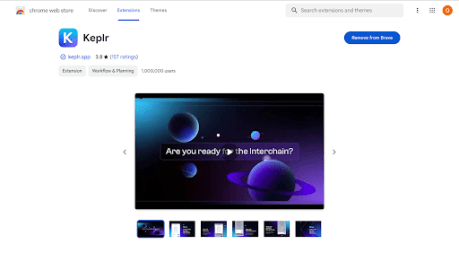
Once connected to your Keplr wallet, go to Keplr using the extension on your Chrome browser, click on the hamburger sign in the top left corner, and select “Manage Chain Visibility”:
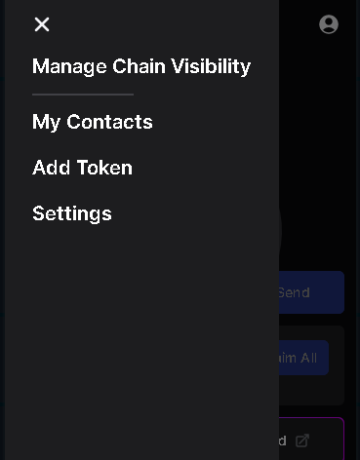
Click on the search bar, next type in SEI, Enable it, and Save it:
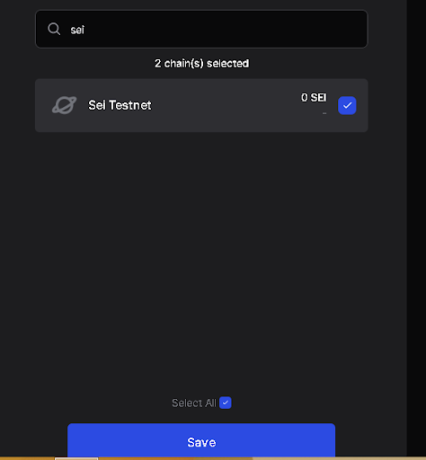
How To Buy And Trade SEI On Centralized Exchange Platforms
To embark on the journey of acquiring SEI, one can explore various prominent exchanges where SEI is listed. Platforms such as Binance, Kucoin, and COINEx offer a convenient gateway for purchasing SEI.
- Create or log in to an account with any of the exchanges listed above.
- Deposit Funds: After logging in, using the image below click on “deposit” to deposit funds into your account using any supported cryptocurrencies or deposit methods available on the exchange. Having funds in your account enables you to execute trades seamlessly.
- Navigate to SEI Trading Page: Once your account is funded, go to the dedicated SEI trading page or type “sei” in the search bar for easy navigation. Here, you can find various trading pairs with SEI tokens.
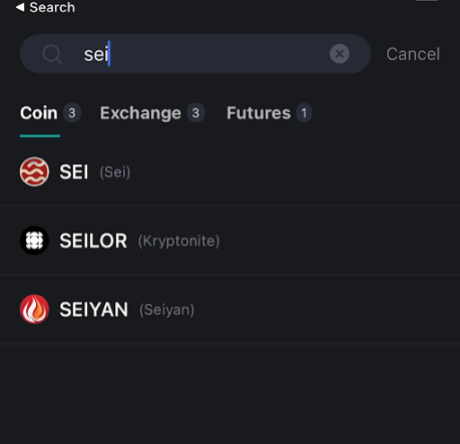
- Choose a Trading Pair: Select the desired trading pair that matches SEI with another cryptocurrency. For instance, you may choose SEI/USDT if you wish to trade SEI against USDT (Tether).
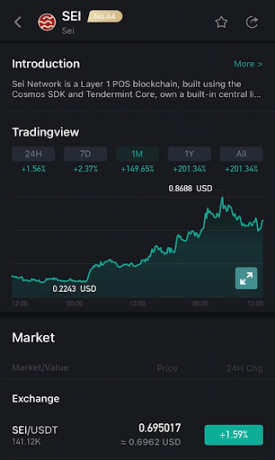
- Specify the Purchase Amount: Determine the quantity of SEI tokens you want to purchase. Input the amount in the trading interface, which will calculate the corresponding cost based on the current market price.
- Execute the Trade: With the specified amount, proceed to execute the trade. Confirm the details, and if you are satisfied, submit the order. By following these comprehensive steps, you can easily trade SEI on CoinEx, taking advantage of the available trading pairs.
Related Reading: Celestia Network: How To Stake TIA And Position For 5-Figure Airdrops
Once you’re done, go to your Keplr wallet, click on Deposit, and copy your SEI wallet. Then go over to your centralized exchange account, click on Withdraw, and then send your SEI tokens to your Keplr wallet address you copied earlier. (Always double-check to make sure you have the correct wallet address).
The SEI network is quite fast so the tokens should arrive in your Keplr wallet in a matter of minutes. As soon as the SEI tokens arrive in your wallet, you’re ready to start trading tokens on the network.
How To Trade Tokens On SEI Network Using Keplr Wallet
To start trading on the SEI network, navigate to the Astroport decentralized exchange (DEX). Visit the site’s homepage and click on “Start Trading” as indicated in the top right corner in the image below:
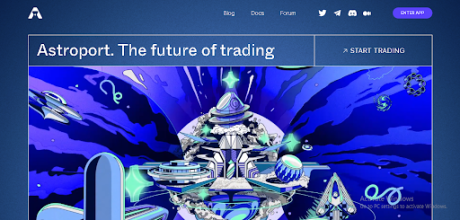
The next step is selecting the SEI Network and clicking on the “Connect Wallet” option on Astroport at the top right corner as illustrated below:
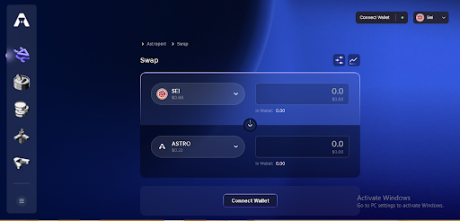
Connect to your preferred wallet, in this case, it’s Keplr wallet:
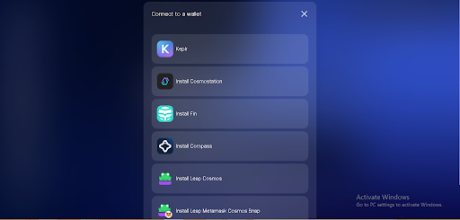
Once connected and the SEI network is enabled you can now trade on the SEI network by navigating to the DEX (decentralized exchange) in this case using Astroport and selecting the token pair you wish to trade.
You can search for the token you want to trade using the name or the contract address obtained from the project’s website or official social media handles. Select the amount of SEI tokens you want to convert to the new token and click “Swap.”
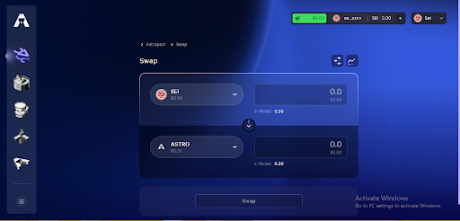
Once the transaction has been confirmed, your tokens will be transferred to your connected (Keplr) wallet. Rinse and repeat to buy and sell tokens on the SEI network.
Tracking SEI Token Charts
Users can also utilize Coinhall to check charts, providing valuable market insights. Coinhall offers two distinct advantages: comprehensive charting tools that provide in-depth market analysis, and real-time access to valuable insights for making informed trading decisions.
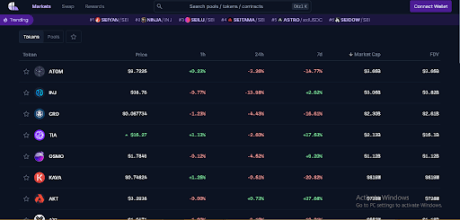
Conclusion
SEI network offers a fast, efficient, and cost-effective platform for buying and trading tokens. With its optimized infrastructure, SEI can handle large transaction volumes quickly and at low fees. It is the first sector-specific Layer 1 blockchain, specialized for trading to give exchanges an unfair advantage.
The SEI token has been able to maintain strong investor support on their platforms including a seven-day rally leading to over 43% surge. The network’s features, such as its speed, frontrunning protection, twin-turbo consensus mechanism, and native matching engine, make it an attractive choice for trading enthusiasts.
SEI’s native cryptocurrency, SEI token, serves various purposes within the ecosystem, including covering transaction fees, staking for rewards, and participating in governance.
Robinhood crypto trading rises 75% in Nov, CEO tips ‘9 figures' in revenue

The trading platform posted a sharp rise in monthly crypto trading volumes in November, while CEO Vlad Tenev said he hopes to eventually reel in “nine figures” in annual revenue.
Is Bitcoin overheated? Some believe the answer is hiding in PEPE

Some crypto market observers believe a rush into memecoin token PEPE could herald an impending Bitcoin dump, but not everyone is convinced.
Bitcoiner who tried to trade his way to Alaska shares his ‘humbling’ experience

Despite coming up short of his goal, crypto trader Thomas Kralow said the crypto-funded expedition was all about two things: “Bitcoin and happiness.”
Crypto bull run: Traders share their plans for the ‘tornado’ to come

Millions of new crypto investors could be experiencing their very first bull run soon, and those who’ve been through it have shared how they plan to tackle it.
Sei, Blockchain Designed for Trading, Goes Live but ‘Frustration’ Mounts Over Airdrop
The buzzy blockchain project’s SEI token saw a flurry of trading as it debuted on several crypto exchanges Wednesday, but there was much confusion over the status of a promised token “airdrop” to early adopters of the network.
Nearly half of crypto copy traders are Gen Z, says Bitget report

Younger investors are more likely to take part in copy trading or social trading and take advice from social media influencers, according to the crypto exchange.
CEX trading volumes fell to 4-year lows even before Binance, Coinbase suits

Monthly trading volumes on centralized exchanges continued to fall in May as regulators tighten their grip on the industry.
Robinhood’s Q1 crypto revenue drops 30% from the previous year

The money coming in for the trading app’s crypto business reached $38 million over the first quarter of 2023, down from $54 million in Q1 2022.
What is profit and loss (PnL) and how to calculate it

PnL refers to the financial gain or loss from buying and selling cryptocurrencies. To calculate it, use various method like the FIFO, LIFO, YTD, and more!
As Crypto Grows, so Does CoinDesk’s Commitment to Keeping Pace
A new CoinDesk tool called the Bitcoin Trend Indicator can help traders spot where BTC is headed.
